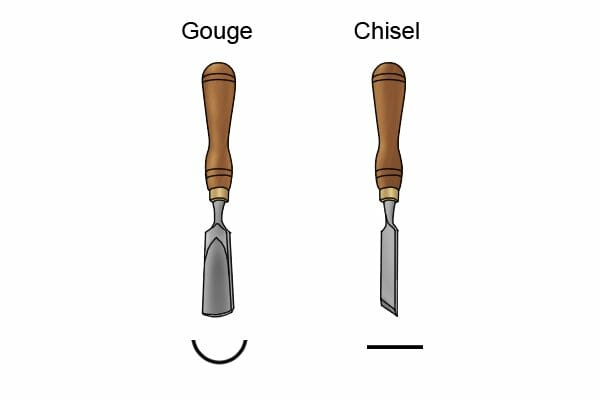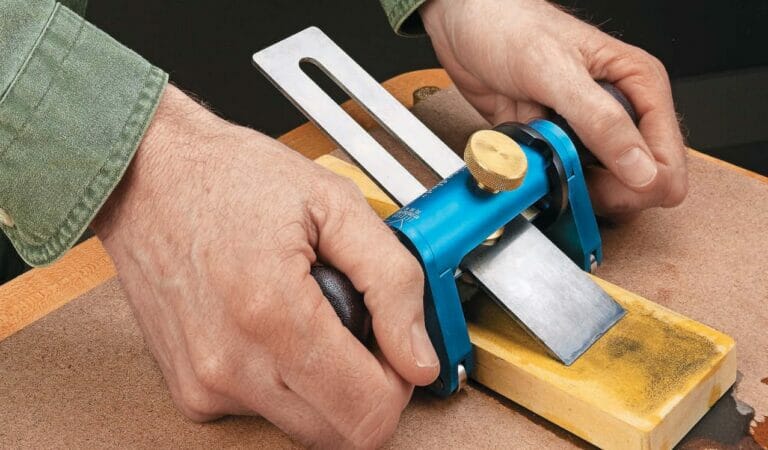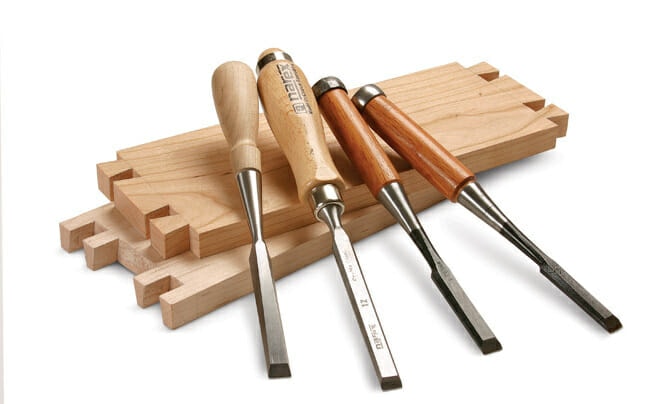
So you’re curious about woodworking tools, huh? Well, let’s get right down to the basics. What’s the difference between a chisel and a gouge? Don’t worry, I’ve got you covered!
Now, picture this: You’re in your workshop, ready to create something amazing out of wood. You reach for a tool and…wait a minute, which one should you use? That’s where the difference between a chisel and a gouge comes in!
A chisel is like a trusty sidekick for a woodworker. It’s a sturdy and sharp tool with a flat blade, perfect for shaping and carving wood. On the other hand, a gouge has a curved blade that’s ideal for carving out hollows or creating intricate details. So, whether you’re looking to make precise cuts or add some texture to your work, knowing the difference between these two tools is crucial. Let’s dive in and explore further!
What’s the Difference Between a Chisel and a Gouge?
A chisel and a gouge are both valuable tools for woodworking, but they have some key differences. While a chisel has a flat blade and is used for cutting, chopping, and shaping wood, a gouge has a curved blade and is primarily used for carving and creating intricate details.
Chisels provide more control and precision, while gouges are ideal for creating hollows and concave shapes. Understanding these distinctions will help you choose the right tool for your woodworking needs.
The Anatomy of a Chisel
A chisel is a cutting tool with a sharp, beveled edge at one end and a handle at the other. The blade of a chisel is typically made of hardened steel, providing strength and durability. Chisels come in different shapes and sizes, each designed for specific tasks. The most common types of chisels include bench chisels, mortise chisels, and paring chisels.
Chisels are primarily used for cutting and shaping wood by hand. They are often struck with a mallet or a hammer to remove material or create precise features such as joinery or decorative elements. Chisels are versatile tools that can be used for tasks such as chopping, paring, and cleaning up rough edges. They are indispensable in woodworking and are found in the toolkit of every woodworker, from hobbyists to professionals.
When selecting a chisel, consider factors such as the blade material, handle ergonomics, and the type of woodworking you’ll be doing. A good quality chisel should have a sharp and durable blade, a comfortable grip, and a reliable method of attaching the blade to the handle to prevent any accidents or mishaps during use.
Knowing the Gouge
Unlike a chisel, a gouge has a curved cutting edge. It resembles a spoon or a shallow bowl, with the cutting edge formed by the inner surface of the curve. Gouges are commonly used in carving, sculpting, and shaping wood, particularly in intricate or decorative work. They are available in various sizes and shapes, each designed to create different cuts and patterns.
Gouges are often used to remove large amounts of material quickly or to create curved or concave shapes in wood. The curved cutting edge allows for controlled, precise cuts, making them suitable for carving intricate designs or creating decorative elements. Gouges are commonly used in woodworking, but they are also found in other industries such as metalworking and stone carving.
When choosing a gouge, consider the size and curvature of the blade, as well as the quality of the cutting edge. A sharp, well-maintained gouge is essential for achieving clean, smooth cuts without tearing or splintering the wood.
Chisel vs. Gouge: The Differences
While both chisels and gouges are cutting tools used in woodworking, there are several key differences between the two:
- Shape: Chisels have a straight cutting edge, while gouges have a curved cutting edge.
- Uses: Chisels are versatile tools used for chopping, paring, and cleaning up rough edges. Gouges are primarily used for carving, sculpting, and creating decorative elements.
- Cutting Action: Chisels are struck with a mallet or hammer to remove material, while gouges are pushed or pulled along the wood to create curved or concave shapes.
- Blade Configuration: Chisels typically have a flat or beveled cutting edge, while gouges have a curved cutting edge.
- Availability: Chisels are widely available and come in various sizes and types. Gouges are more specialized tools and may be harder to find, especially in specific sizes or shapes.
Understanding these differences can help you choose the right tool for your specific woodworking needs. Whether you’re working on joinery, carving intricate designs, or shaping wood for decorative purposes, selecting the appropriate tool can enhance your woodworking experience and ensure the best results.
Choosing the Right Tool for Your Woodworking Needs
Now that we’ve explored the differences between chisels and gouges, let’s dive deeper into selecting the right tool for your woodworking needs. Whether you’re a beginner or an experienced woodworker, having the appropriate tools can greatly impact the outcome of your projects. Here are some factors to consider when choosing between a chisel and a gouge:
Project Requirements
Consider the specific requirements of your woodworking project. Do you need to remove large amounts of material quickly, or are you working on intricate carvings or joinery? Understanding the scope and intricacy of your project will guide you in selecting the appropriate tool.
Skill Level
Consider your skill level and familiarity with each tool. Chisels are generally more versatile and beginner-friendly, making them a suitable choice for those new to woodworking. Gouges, on the other hand, require more skill and precision due to their curved cutting edge.
Budget
Take into account your budget when making a decision. Chisels are generally more affordable and readily available, while gouges, particularly high-quality ones, can be more expensive. Consider your budgetary constraints and prioritize accordingly.
Tool Quality
Investing in high-quality tools is essential for achieving the best results. Consider the quality and craftsmanship of the chisels or gouges you’re considering. Look for tools made from durable materials with sharp cutting edges that can be easily maintained and sharpened.
Personal Preference
Ultimately, personal preference plays a role in selecting the right tool. Some woodworkers may prefer the versatility and simplicity of a chisel, while others may enjoy the control and precision offered by a gouge. Consider your own preferences and comfort level with each tool before making a decision.
By considering these factors, you’ll be able to choose the right tool for your woodworking needs. Whether you opt for a chisel or a gouge, both have their unique benefits and applications in woodworking. With practice and experience, you’ll discover the nuances and versatility of these tools, allowing you to elevate your woodworking projects to the next level.
Maintaining and Caring for Your Tools
To ensure the longevity and performance of your chisels and gouges, it’s important to properly maintain and care for them. Here are some tips for keeping your tools in excellent condition:
Sharpening
Regularly sharpen your chisels and gouges to maintain a keen cutting edge. Invest in a quality sharpening system or learn the proper hand sharpening techniques. Keep your tools sharp to achieve clean, precise cuts and prevent damage to the wood.
Storage
Store your chisels and gouges in a dry and clean environment. Avoid exposing them to moisture, as it can cause rust and corrosion. Consider using a tool roll or a dedicated storage case to protect your tools from damage or accidental contact.
Cleaning
After each use, clean your tools thoroughly. Remove any wood shavings or debris and wipe them dry. Consider applying a thin layer of protective oil to the metal parts of your tools to prevent rust and corrosion.
The Bottom Line
Knowing the difference between a chisel and a gouge is crucial for any woodworker. These tools, while similar in some ways, serve distinct purposes in woodworking. By considering the shape, uses, cutting action, blade configuration, and availability of each tool, you can make an informed decision when selecting the right tool for your projects.
Remember to consider factors such as project requirements, skill level, budget, tool quality, and personal preference to choose the tool that aligns with your woodworking needs. Lastly, maintain and care for your tools to ensure their longevity and performance. Enjoy the process of working with chisels and gouges and watch your woodworking skills flourish!
Frequently Asked Questions:
Are you curious about the difference between a chisel and a gouge? Look no further! Below, we answer some common questions that can help clear up any confusion you might have.
1. How do chisels and gouges differ?
Chisels and gouges are both cutting tools used in woodworking, but they have distinct differences. A chisel has a straight, flat blade with a sharp edge on one side, usually made of steel. It is used for precise cutting, shaping, and carving. On the other hand, a gouge has a curved or concave blade with a rounded edge. It is often used for scooping, carving hollows or grooves, and creating intricate details.
While chisels are primarily used for making straight and flat cuts, like removing material or creating sharp edges, gouges are better suited for making curved cuts or hollowing out surfaces. Gouges provide more control and flexibility when shaping wood, especially for more organic or intricate designs.
2. Which tool is better for cutting through tough materials?
When it comes to cutting through tough materials, like hardwood, a chisel is generally the preferred tool. The straight, sharp edge of a chisel allows for more efficient and controlled cutting through dense wood fibers. Its flat blade can withstand greater pressure and is less likely to chip or break when used correctly.
Gouges, on the other hand, are typically used for softer materials or for shaping and carving rather than heavy-duty cutting. The curved blade of a gouge is not designed for aggressive cutting and may be more prone to damage or dulling when used on tough materials.
3. Can chisels and gouges be used interchangeably?
In some cases, chisels and gouges can be used interchangeably, depending on the task at hand. However, it’s important to consider the specific characteristics of each tool and how they may affect the outcome of your work.
For example, while a gouge can be used to make straight cuts, it may not provide the same level of precision or clean edges as a chisel. Similarly, using a chisel for curved cuts or intricate details may be more challenging and less effective than using a gouge.
It’s best to choose the tool that is specifically designed for the task you are working on to achieve the best results. Having both a chisel and a gouge in your tool collection will give you more versatility and options when it comes to woodworking projects.
4. Are chisels and gouges suitable for beginners?
Both chisels and gouges can be used by beginners, but it’s important to start with the right tools and practice proper technique.
For beginners, starting with a few basic chisels in different sizes and learning how to handle and sharpen them is a good foundation. Chisels are more straightforward to use for general woodworking and can be easily mastered with practice.
Gouges, on the other hand, require a bit more skill and control due to their curved shape. They are great for more advanced woodcarving techniques or for those who want to delve deeper into intricate designs. Beginners might benefit from starting with smaller gouges and gradually working their way up to larger sizes as they gain experience and confidence.
5. What safety precautions should I take when using chisels and gouges?
Using chisels and gouges involves sharp blades and requires caution to ensure safety. Here are a few essential safety precautions to follow:
– Always wear safety goggles to protect your eyes from flying wood chips or debris.
– Keep your work area clean and free from clutter to avoid accidents.
– Use a sharp tool to reduce the risk of slipping or applying excessive force.
– Hold the tool firmly with one hand and use your other hand to guide the cutting edge away from your body.
– Cut away from yourself, not towards yourself, to minimize the risk of injury.
– When not in use, store chisels and gouges in a safe location, such as a tool chest or a rack, to prevent accidental contact and maintain their sharpness.
Remember, safety should always be a priority when working with sharp tools.
So, to sum it up, a chisel and a gouge are both tools used in woodworking, but they have some key differences. A chisel has a straight edge and is used for cutting and shaping wood, while a gouge has a curved edge and is great for carving and hollowing out wood.
Chisels are typically used for making straight, clean cuts, while gouges can create more intricate shapes and designs. So, depending on what you’re trying to create, you’ll want to choose the tool that suits your needs. Remember, practice makes perfect, so don’t be afraid to experiment and see which one you prefer!



